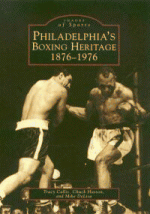[Previous entry: "Photo of the Day: Boxing Judge Gary Merritt & Wife in New Orleans!"] [Main Index] [Next entry: "Mark Evans: Artist & Director"]
12/20/2008 Archived Entry: "Billy Soose, a Great Middleweight Rediscovered"
Billy Soose, a Great Middleweight Rediscovered
By Tom Donelson
Billy Soose is now part of the International Boxing Hall of Fame. Gene Sebastian, his younger brother, spent much of the past two decades workign to get his older brother into the Hall of Fame and the proper recognition due to this amazing fighter.
As an Amatuer and collegiate fighter, Soose' forte was power. As a college fighter, he was so good that NCAA outlawed golden glove champions from competing and this legislature was directed at Soose. Soose knocked out every collegiate fighter he competed against and many college teams refuse to compete against him.
Soose continued his winning way in the amateur rank and when he turned pro, Soose's right hand would be his ticket to fame. Early in his career, Soose fought Al Quail and in the process of beating Quail, he split in the tendon onhis middle knuckle. From his point, Soose lost the power to punish his opponent and switched from slugger to boxer. What made Soose a great fighter is his ability to adopt. Once he lost his right hand, he became a boxer. Rarely has a boxer made as dramatic switch in style as Soose did. Rarely can fighter change style in the midst of a career but the greatness of Soose adoptablity in rare in boxer. Could you imagine Goerge Foreman having to turn himself into a boxer? Or Joe Frazier? You understand the magnitude of what Soose accomplished.
For this alone, Soose deserved being in the International Boxing Hall of Fame. Soose's left hand became his weapon and the right hand was thrown more for show. Soose essentially was a one handed fighter but what a one handed fighter! Never had one boxer done so much with one hand. In 1940, Soose defeated the two recognized middleweight champions in a non-title in a period of one month. Ken Overlin and Tony Zale fell victim to be left jabbing Soose. A year later, Soose defeated Overlin to claim the Middleweight championship in a close battle. He became the accepted king of the 160 pound division.
After winning his Middleweight title, he vacated his title to campaign for the lightweight champion. After winning two fights, he lost to Jimmy Bevins in his last fight. World War II would cut his career short and with real estate holdings enhancing his portfolio, Soose did not come back to the ring after the War.
He was offered $100,000 to fight again but he turned it down for he promised his wife that he would retire and he had businesses to run. War ended and so did Soose's career. There was nothing to prove and at the age of 30, he had a life ahead of him. Unlike most boxer, he no longer needed to fight.
Why did it take so long before being voted into the International Boxing Hall of Fame? World War II cut his career short and he never fought after the age of 26. He did not have the longevity of career that many boxing writers viewed necessary. Another reason is that he did not knock people out bu beat them with his guile and lateral movement. Without a devastating right hand to bail him out, Soose depended upon his jabs.
After Soose lost a close decision to the great Charles Burley early in his career, he sat distraught in his locker. His trainer, the great Ray Arcel, reminded his charge that he just lost to one of the great fighters fighting with just one hand. This lost became a learning experience that he used to jumpstart the rest of his career.
Soose abilities had been lost in the history of boxing for many decades and overshadowed by other great middleweights of that era like Tony Zale. Boxing have now rediscovered one of boxing's great gem. Soose is now in the Hall of Fame and now he will be forever remembered as one of boxing all-time greats.
* * *
Boxing fans and pundits:
Some thoughts on Billy Soose. I will add that co-authored a book with Rusty Rubin on Soose and the book is available through Author house.com For more information, you can call me at 319-331-7615.
Sincerely,
Tom Donelson

